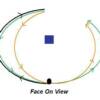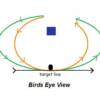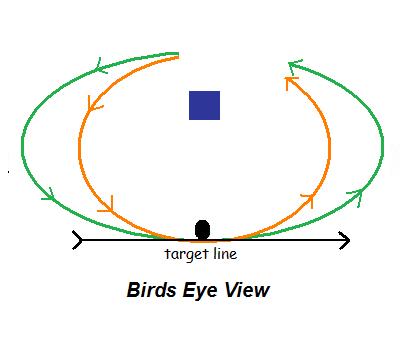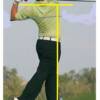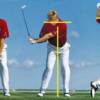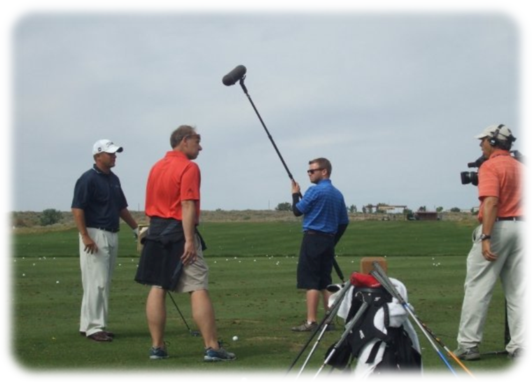Forward Swing Arc: Get Wide
The above diagram (above and right) depicts the main difference between the On Plane Swing and the other swings being taught today. It is the essence of the On Plane Golf Swing. It is the reason why I place the diagram front and center on every page of this website (click on the diagrams to expand them). I am a HUGE proponent of a wider foward swing arc. What does a wider forward swing arc mean to your golf swing? The club head's 'vertical' angle of ascent into the golf ball is shallow and the club head's 'directional' angle of approach to the golf ball is down the target line. These are the main differences between the On Plane Swing and the other swing systems out there today.
Vertical Angle of Approach: Incorporating a wide foward swing arc into your golf swing, the club head will travel into the golf ball (impact) at a shallow angle of approach and not a steep angle of approach (face on view diagram). A very good visual is this... picture an airplane landing on a runway. If the pilot does his job correctly, the airplane will touch ground on a shallow angle of descent. If the pilot does not do his job properly, the airplane will touch down on a more severe angle of descent (and you know the outcome of this). A shallower angle of approach with the club head has another benefit. You will direct the club head's energy (speed) more into the golf ball and less into the ground (more ball speed). My video will explain this in greater detail.
Another extremely important feature of a wider downswing arc (in my opinion) is... when you arrive to impact on a shallow and wide arc you will not encourage a super 'late release' of the hands (or super late down lag if you will) up to the moment of impact. Let me explain this very clearly...because if misinterpreted, you will be lost in the never ending puzzle of a compensational golf swing.
There has been much made about down lag, late lag, late release and how desirable it is to have in the golf swing and how 'all the tour pros do it that's why they hit the ball so far'. Fact...all of your good golfers/tour pros have late to super late lag in their foward swing. Fact... the later you release the club in the forward swing the more club head speed you can create. Fact... the later you release the club, the more you deloft the club (pros turn a 7 iron
Directional Angle of Approach: Now the other benefactor in the wide forward swing arc is the club head's 'directional' angle of approach at impact (the birds eye view diagram). By swinging wide (as I refer to it with my students), the club head will travel for a longer time ... 'down the target line' during impact. The results of this are ALL positive. First, the club head is moving towards the target during impact and not 'rounding off' to the left during/after impact (the S&T and the One Plane Swing, the club is traveling left at impact or very shortly after impact). If the club head is traveling to the target at impact there is a good chance the ball is going to travel to the target after it leaves the club face (assuming the club face is square to the arc at impact). Now, why does the club head travel down the line during the On Plane Swing? During the forward swing arc, your upper body torso (waist up) will move laterally towards the target (dynamic transfer of weight). In essence, your shoulders and torso will be 'covering' the ball during and post impact. There is no... head behind the ball at impact or a reverse C finish with the On Plane Swing. 'Covering the ball' will be discussed in great detail in the Dynamic Transfer of Weight section and the Shoulders section of this website. Anyhow.. by moving your torso towards the target at impact and post impact you have effectively widened/flattened the forward swing arc pre, during, and post impact (from the birds eye view). Geometrically speaking... the 'On Plane' swing has a wider forward swing arc than other swing theories. With the 'Hogan Arc', the 'One Plane Arc', and the 'Stack & Tilt Arc', the clubhead travels on the target line for a shorter duration during impact. This will lead to golf ball curvature UNLESS your timing is perfect or close to perfect.
into a 6 iron, a 6 iron into a 5 iron, etc). Fact... the later you release the club in the forward swing the more hand/eye coordination (perfect timing) you will need to achieve a satisfactory impact position. Why is this? The more you 'hold' onto the release (or later lag), the later the club face will remain 'open' to the swing arc. Well..as you approach impact...the late release is holding 'open' the club face until the last possible millisecond. What happens next is a necessity. Your hands will flip and your hips will spin open ONLY to make an attempt to square the club face up at the last possible millisecond. The result... the 'spin & flip' (hips and hands): a BIG push slice, push fade, shank, or my favorite.... the pull hook, and once in a very blue moon... the clubface will be square at impact (albeit a lower trajectory) and a fairly playable shot will result. All of this from releasing the club too late during the forward swing arc.
I'll give you an example: April 1997, Augusta GA, day 4 of the 'Tiger Romp' at the Masters. Tiger Woods hit off the 13th tee par 5 with his 3 wood. As soon as the ball left the club face... Tiger cursed at himself even before he looked up to see where his tee ball was heading. He was disgusted with himself because he understood what just happened in his golf swing. He released the club way to late in during his forward swing. From his past experiences playing golf, he knew there is about a 10% chance of his tee shot ending up in play. The other 90% will involve a hook or block slice (one is fatal on that tee shot). Now, that being said, if you can remember, his 3 wood was hit low with a draw down the middle and around the corner. Then, he happily smiled and showed the viewing public the 'flip' sign of a late release. He was very fortunate with that swing. He got away with it. His last millisecond adjustment before impact created a satisfactory golf shot. He understood this...hence the devilish smile to the camera. The viewing public thought he was being a spoiled kid because of his the tee shot ended up in play and he disapproved of how it got there. Point being...there is that very delicate balance between a 'too late release', 'properly timed release', and an a 'premature release' during the forward swing. Very simply put, the On Plane Swing with the wider forward swing arc bridges the gap between too late and too early. How does it do this? Very simply... the wider arc you have on the forward swing, the longer the 'runway' is essentially, the longer the runway is, the more time your body has to achieve proper impact position without last millisecond compensations. Back to the airplane example. Is it easier to land a plane on a short runway or a longer runway? You can decide. I already have.
Green: 'On Plane' Forward Swing Arc.
Orange: 'Tradtional' Forward Swing Arc.
Notice: 'On Plane' Arc will travel on the 'target line' more than 'Traditional' Arc
A word about Posture: A lot has been said recently about Tiger's recent struggles and how EVERYTHING is due to his foward swing arc posture varying from his address posture. If you watch closely Tiger's head and spine angle actually lower during the forward swing arc. It seems EVERY TV instructor jumps on the same bandwagon about how this is his REAL problem. I will tell you this. It's not and not even close. I have slow motioned Tivo'd just about every golfer on Saturday and Sunday on TV (you can as well) and EVERYONE has the 'Tiger' move on the forward swing. And I literally mean, EVERYONE. In fact... every tour professional does it/ did it/ and I will go out on a limb and predict will do it in the future. The forward swing arc is the 'action ' arc, so to speak. It's where we actually 'strike' the golf ball. When we strike the ball properly, we naturally strike down at the golf ball with our irons (and fairway metals sometimes). In a nutshell, your body is anticipating this strike and adjusts itself accordingly in anticipation for the strike. Wayne DeFrancesco, a top 50 PGA golf instructor (www.waynedefrancesco.com) refers to this as compression. I STRONGLY encourage you to visit his site on this phenomena and realize that EVERY great golfer compresses/compressed during the golf swing. He has videos of every great golfer that has ever lived (visit his website and view them...it's very interesting) and they ALL perform compression on the forward swing (even Johnny Miller and Brandel Chamblee). Compression is fundament trait of the correct impact postion. As a student, this 'compression' is something you must accept and do not try to discourage it.
'Create Width' in the forward swing arc
(double click to expand video)
Adam Scott's Wide Forward Swing Arc
(double click to expand)
Jason Dufner's Forward Swing Arc
(double click to expand)
Phil Mickelson's Narrow Forward Swing Arc
(double click to expand)
